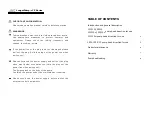
mode can be particularly useful when an RF base or serial sensor is behind a firewall and needs
to be the party responsible for initiating the TCP socket connection to the data collection server.
The NL241 will attempt to open a connection with the remote server, and, if the connection fails
to open, the device will continue to retry at an interval of 60 seconds. If data arrives on the RS-
232 port when no TCP connection exists, the device will buffer the data (up to 1500 bytes) and
immediately attempt to open a connection to deliver the data. If the remote server closes the
connection due to error, the NL241 will make a best effort to save any data that was in process
and re-queue it to be sent on the next successfully-opened TCP connection.
8.2.5 Modbus TCP/IP to RTU Gateway
The NL241 can serve as a Modbus TCP/IP to RTU Gateway. It will listen for incoming Modbus
TCP/IP connections from a Modbus TCP/IP master client. The port number of the listening
connection is specified in the RS-232 (or CS I/O) Service Port setting and is typically set to a value
of 502. The NL241 will convert incoming Modbus TCP/IP frames to Modbus RTU and forward
them to the RS-232 (or CS I/O) port. The NL241 will wait for a response from the Modbus RTU
device and forward that response back to the remote Modbus TCP/IP master client over the
established TCP connection. The Modbus RTU device is generally a data logger connected to the
RS-232 (or CS I/O) port or a data logger located remotely over a transparent radio (for example,
RF450) connection, but can be any Modbus RTU device. When the NL241 is connected directly to
a CR800 series, CR1000, or CR3000 being polled by a Modbus TCP/IP master client, the NL241 is
most commonly configured with bridge mode enabled instead of as a Modbus TCP/IP to RTU
Gateway.
8.2.6 TLS
The NL241 supports transport layer security (TLS) for proxy functions including HTTPS. TLS
versions 1.0, 1.1, and 1.2 are supported. The TLS implementation supports symmetric algorithms
AES-256, AES-128, and RC4 and RSA keys up to 4096 bits. For any TLS connection, the unit will
preferentially use AES-256, then AES-128, and finally RC4. X.509 certificates are supported, with
the exception of v3 extensions. Certificates should be PEM (privacy-enhanced mail) format. Up to
10 certificates can be chained. 10 kB of space is provided for certificate storage. The private key
should also be in PEM format and, if encrypted, use AES-256 or AES-128 (SHA).
The implementation of TLS in the NL241 is provided so that secure, encrypted communications
can be established between a TLS client and the NL241. With the TLS proxy server enabled, the
NL241 can act as a TLS proxy server for a data logger. The NL241TLS proxy server maintains a
secure TLS connection with a remote TLS client and forwards data onto a data logger using a
standard TCP connection thus enabling communications with TLS clients. The TLS client can be a
NL241 Wireless Network Link Interface
33
















































